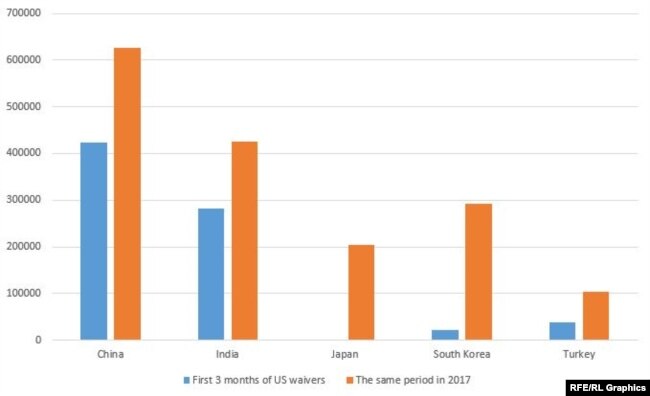Radiofarda – Iran’s oil exports to its five clients rose to 1.7 million barrels per day (mb/d) in March, the highest level since the United States imposed sanctions on Iran in November 2018, Platts reported April 9.
Along with the sanctions, the U.S. also gave a six-month exemption or wavier to eight friendly countries: China, India, Japan, South Korea, Taiwan, Turkey, Italy and Greece to continue buying Iranian oil until May 2, but they were asked to cut Iranian oil intake by 20 percent “in average” during the six-month wavier period.
Taiwan, Greece and Italy didn’t use their waivers and have stopped buying Iranian oil since last November, but Iran’s oil export volume to the other five clients in March is almost as much as their March 2018 import level.
The reason is that these countries did not import as much oil as allowed by the waivers and it seems they tried to make up for the deficit in March.
According to official statistics of five Iranian oil clients, some of them suspended imports before and after waviers. For instance, during November2018-January 2019, the total oil purchases of China, India, Japan, South Korea and Turkey was about 776,000 b/d in average, about 53% less than the same period the previous year (November 2017-January 2018).
Therefore, they attepmted to compensate using their waiver limits as much as possible in February and specially in March 2019. Meanwhile, Washington will decide on wavier extention on May 2 and these countries are not sure don’t whether the exemptions will be extended or not.
The important factor in oil intake by Iranian clients is their “average” imports in 6 months, not purchases in a spesific month.

Recently, Reuters reported that Indian refiners are holding back from ordering Iranian oil for loading in May pending clarity on whether Washington will extend the waivers or not. Japanese refineries have also put a halt on imports of Iranian oil.
Japan had suspended Iranian oil intake during the first half of the waiver period. South Korea also suspended imports during November and December, while Turkey didn’t import any Iranian oil in November.
Therefore, they attempted to boost intakes in February and March, but since Iranian oil transit to East Asian countries takes one month, Japan and India recently suspended any new cargo orders.
Despite the increase in Iranian oil exports in March, its production not only didn’t increase, but it even declined, because Iran has tens of millions of barrels unsold oil in floating storage and it used these reserves to boost exports.
Platts also says that data from Ursa, a geospatial analytics startup, which tracks oil inventories using satellite data, shows that Iran’s crude inventories have fallen by almost 25% since early January.
According to OPEC’s latest report, released April 10, Iran’s oil production in March declined 28,000 b/d, compared to February and reached 2.698 mb/d. It is about 1.11 mb/d less than March 2018, when its exports were above 2.5 mb/d.
- Dalga KhatinogluDalga Khatinoglu is an energy analyst from Azerbaijan who contributes to Radio Farda.
 Shabtabnews In this dark night, I have lost my way – Arise from a corner, oh you the star of guidance.
Shabtabnews In this dark night, I have lost my way – Arise from a corner, oh you the star of guidance.


